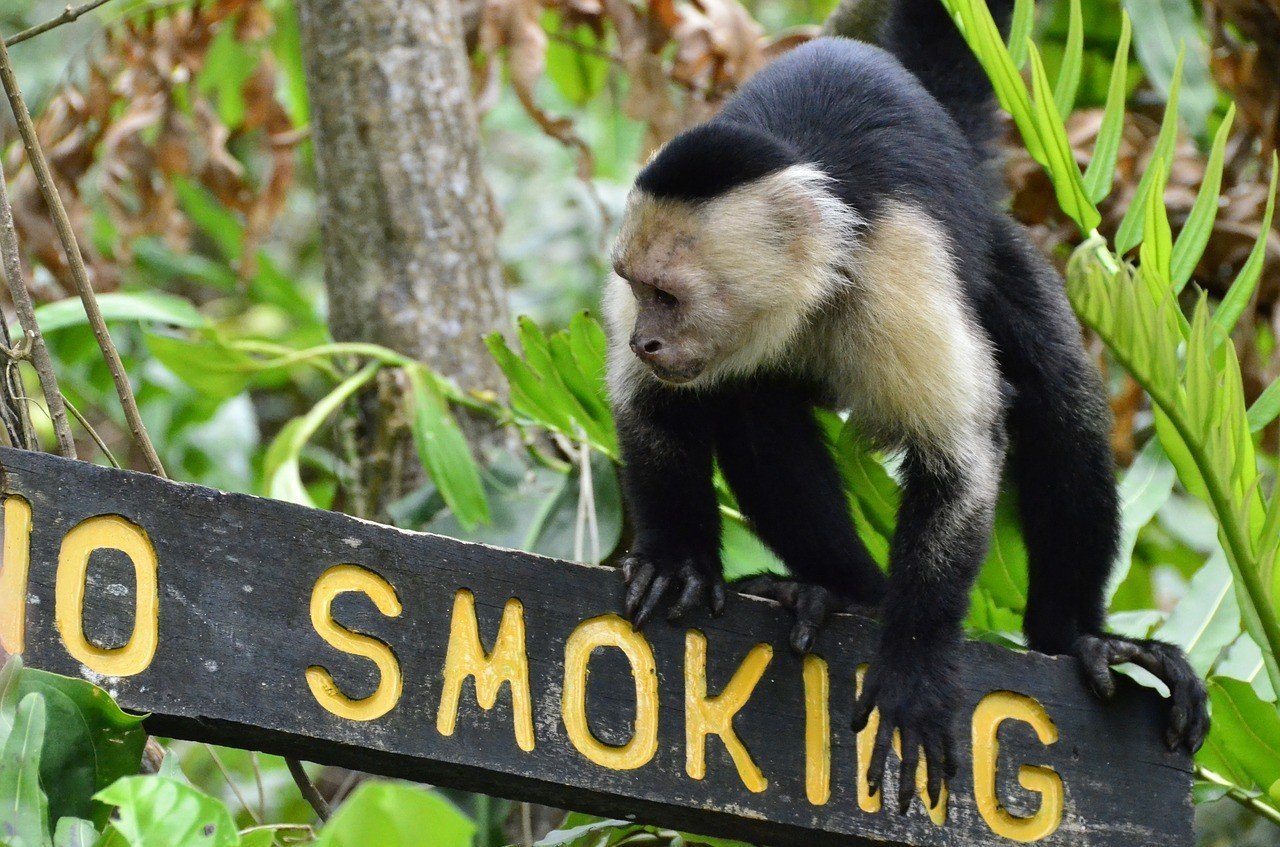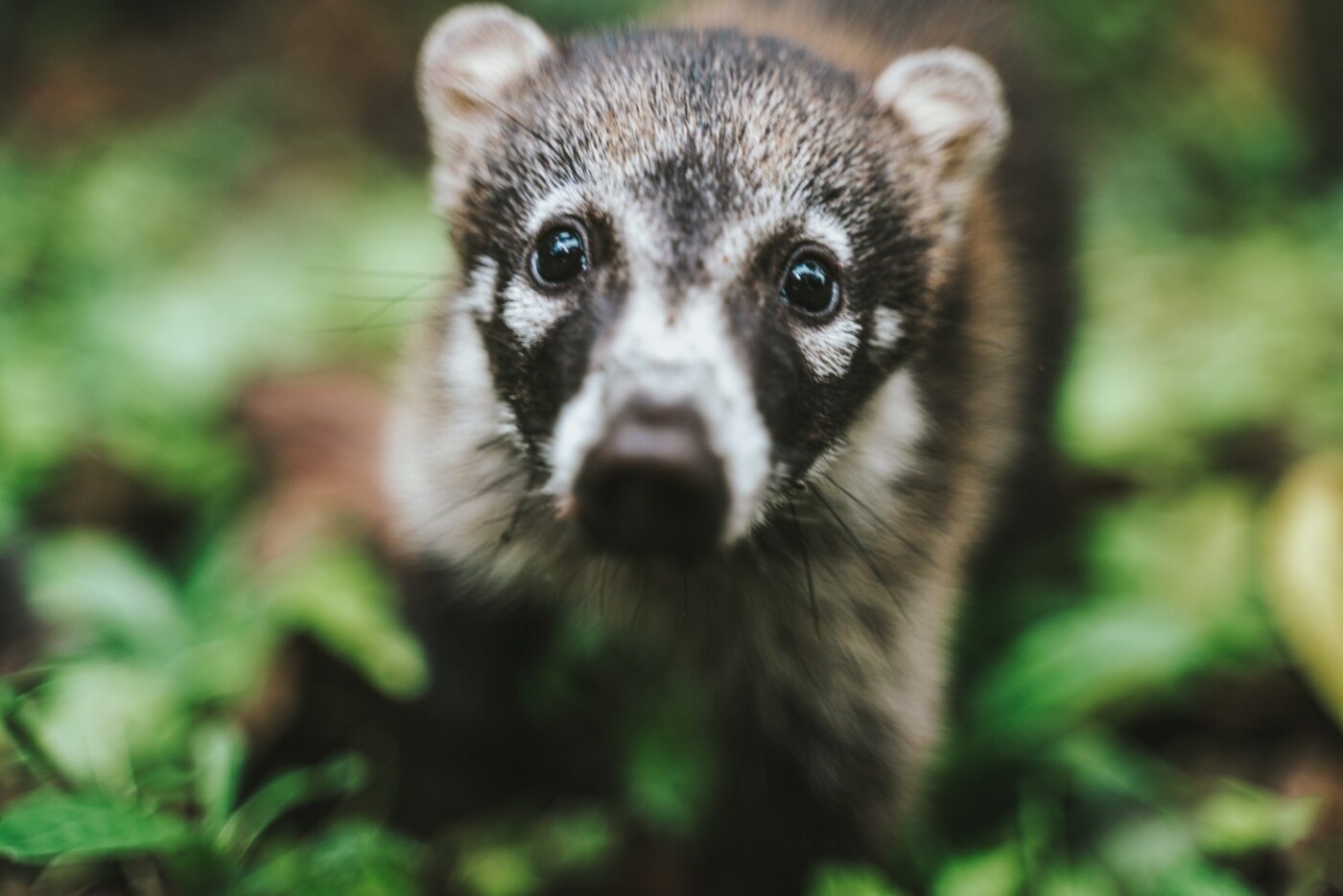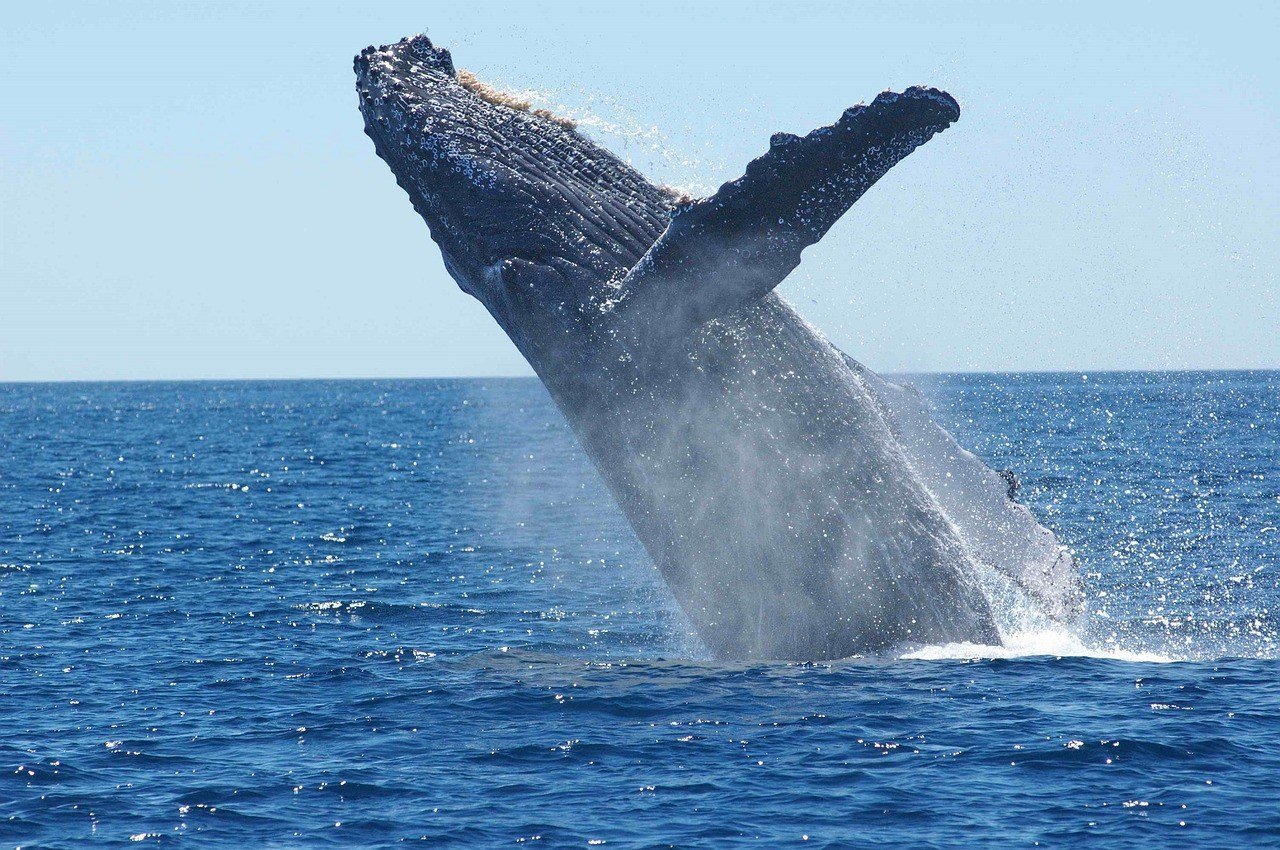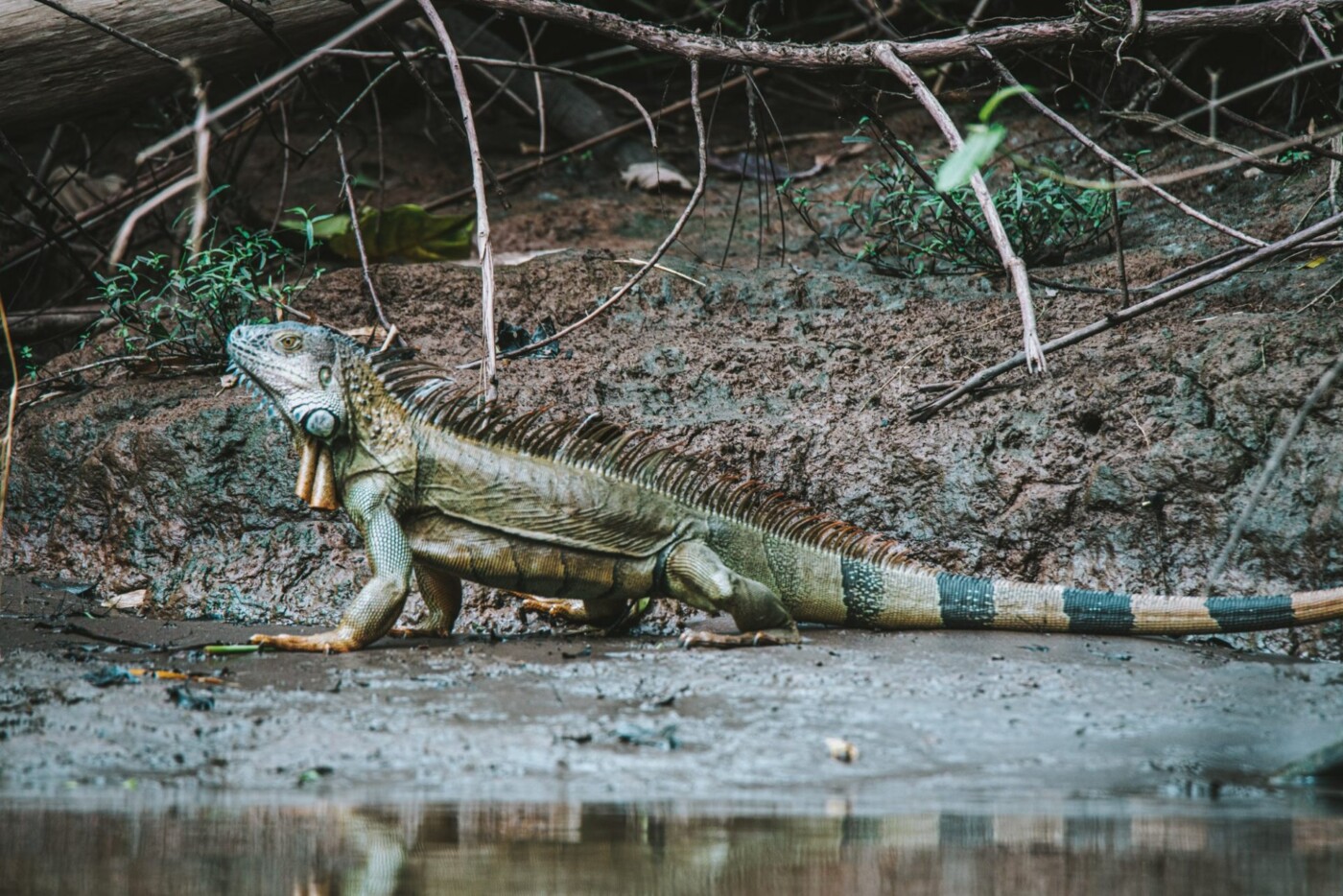Costa Rica is a small country in Central America, but it is home to an incredibly diverse range of wildlife. In fact, it has been estimated that Costa Rica contains around 6% of the world’s biodiversity, despite covering only 0.03% of the planet’s surface area. This makes it one of the top destinations in the world for nature lovers and wildlife enthusiasts.
*This post may contain affiliate links, as a result, we may receive a small commission (at no extra cost to you) on any bookings/purchases you make through the links in this post. As an Amazon Associate, we earn from qualifying purchases. Read our full disclosure
Wildlife viewing is one of the biggest draws for visitors coming to Costa Rica. With its many national parks, reserves, and protected areas, Costa Rica offers ample opportunities to see a wide variety of animals in their natural habitats.
Over the years, we’ve spent a lot of time in Costa Rica, visiting many of its national parks, rainforests and jungles. We’ve been lucky to spot many of exotic Costa Rica animals on our travesl, so here are some of our favourites!
1. Mantled Howler Monkey
Howler Monkeys are native to the tropical rainforests of Central and South America and are one of the easiest animals in Costa Rica to spot on your vacation. They are famous for their loud howl (hence the name howler) that can be heard for miles. Mantled Howler Monkies typically live in groups of 10-30, so if you spot one, it is very likely that there are more around.
They spend the majority of their days resting and sleeping and seem to be most active in early evenings. Don’t worry about keeping an eye out for these guys, you’ll hear them before you see them. They are most prevalent in rural areas with lots of trees and vegetation.
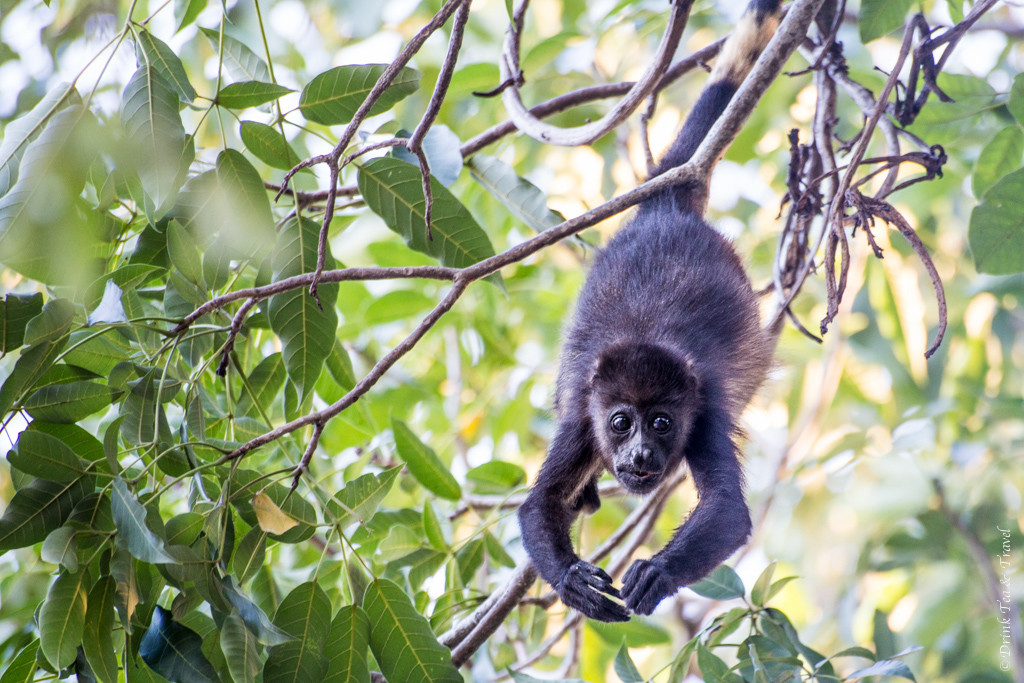
Traveling Soon? Here is a list of our favourite travel providers and accessories to help get you ready for your upcoming trip!
2. White-Headed Capuchin Monkey
You won’t find capuchin monkeys in their true habitat anywhere but in Central America. This Costa Rican animal is highly intelligent and is rather versatile, living in different kinds of forests and eating all kinds of food. These monkeys often hang out in groups of 20-40 and tend to live a long life of over 54 years old.
These are rarer than the howler monkeys, but still easily spotted in areas like Manuel Antonio, Monteverde and other reserves and national parks.
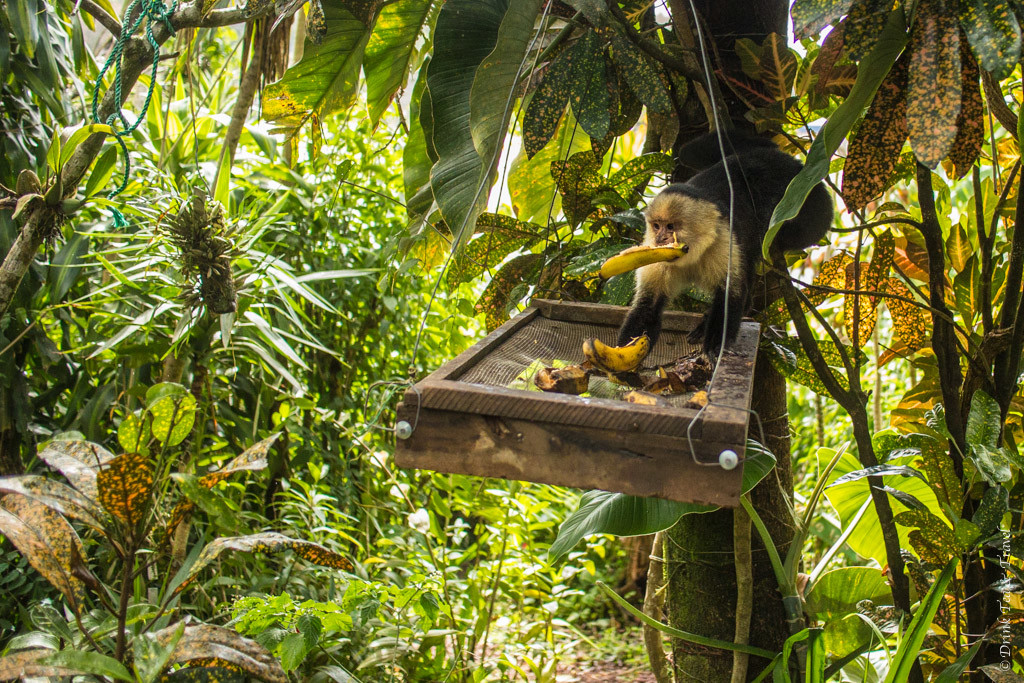
3. Squirrel Monkey
Squirrel monkeys are one of the smallest species of monkeys in Costa Rica, but they are also one of the most agile and active. These tiny primates are easily recognizable by their dark fur and white faces, and they are known for their playful and social behavior.
These monkeys can be found in various regions of Costa Rica, including the Osa Peninsula, Manuel Antonio National Park, and the Monteverde.
Squirrel monkeys are social animals and typically live in groups of up to 30 individuals. They communicate with a range of vocalizations and body language, and they are known for their acrobatic skills and ability to move quickly through the trees.
While the squirrel monkey is not considered endangered,it is threatened by habitat loss and the illegal pet trade. It’s important to observe them from a distance and not feed them, as this can disrupt their natural behaviors and lead to health problems.
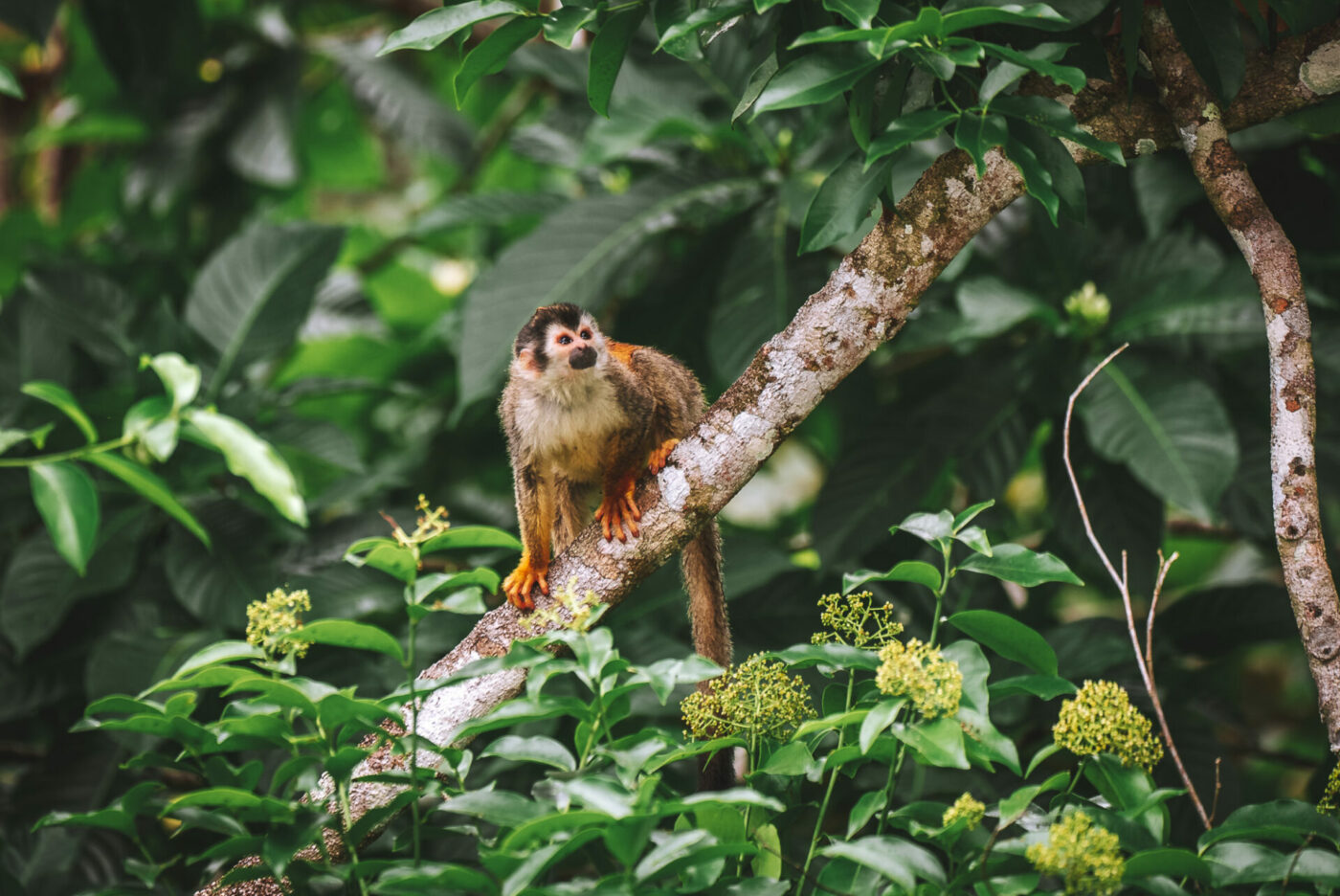
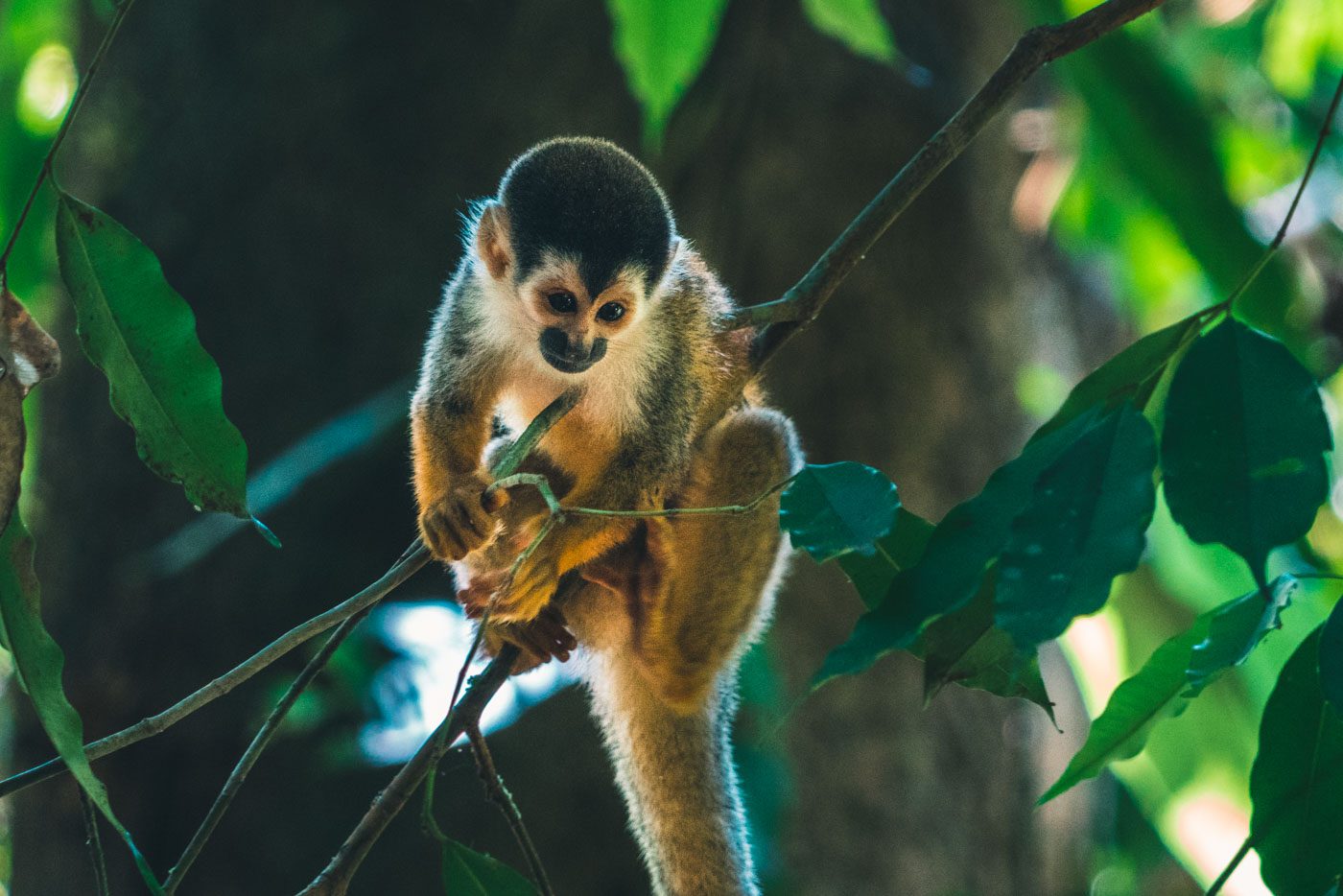
4. Sloths
Known as the national animal of Costa Rica, these tree-living mammals are native to South and Central America. The ones in Costa Rica come in 2 varieties: the two-toed sloths and three-toed sloths.
They spend the majority of their days hanging upside down, asleep for 16 to 18 hours each day. They can’t walk, so if you are hoping to spot one while in Costa Rica make sure to look up high in the jungle canopy.
Two-toed sloths
If you see two-toed sloths in Costa Rica, they’re going to be Hoffmann’s two-toed sloths. They’re sturdy and shaggy and, of course, incredibly slow. Their name actually only applies to their front limbs, as they have three toes on their back limbs. They’re largely nocturnal, and they can live into their 40s.
Three-toed sloths
The three-toed sloth is a bit smaller and a bit slower, if you can believe that. If you see a three-toed sloth in Costa Rica, then it’s going to be a brown-throated sloth. They’re active during the day or at night, but they do sleep for about 18 hours a day. They tend to live to be between 30 and 40 years old.
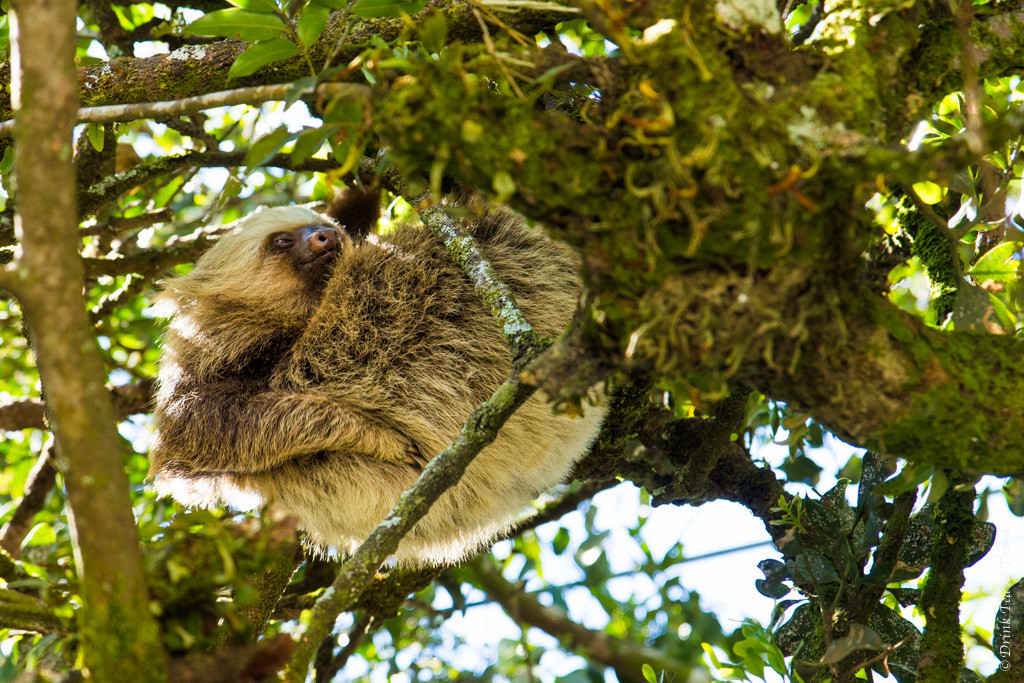
5. Pizote
The pizote is a member of the raccoon family and despite the fact that it doesn’t look like your typical North American raccoon, it certainly possesses a lot of the same behavioural qualities. Pizotes range between 30 and 70cm in length but weigh only about 2-8kgs.
Despite their small frame, they have strong jaws and sharp teeth and, just like their North American cousin, can often be found digging for food in garbage bins.
Outside of Costa Rica, you’ve likely heard them referred to as a white-nosed coati or a coatimundi. Much like raccoons, they’re frequently seen as pests in cities. They’re omnivores and will eat anything they can, even if the locals find it inconvenient. Unlike most raccoons, a coati is happy to make a nuisance of itself during the day or night.
He’s cute, isn’t he?
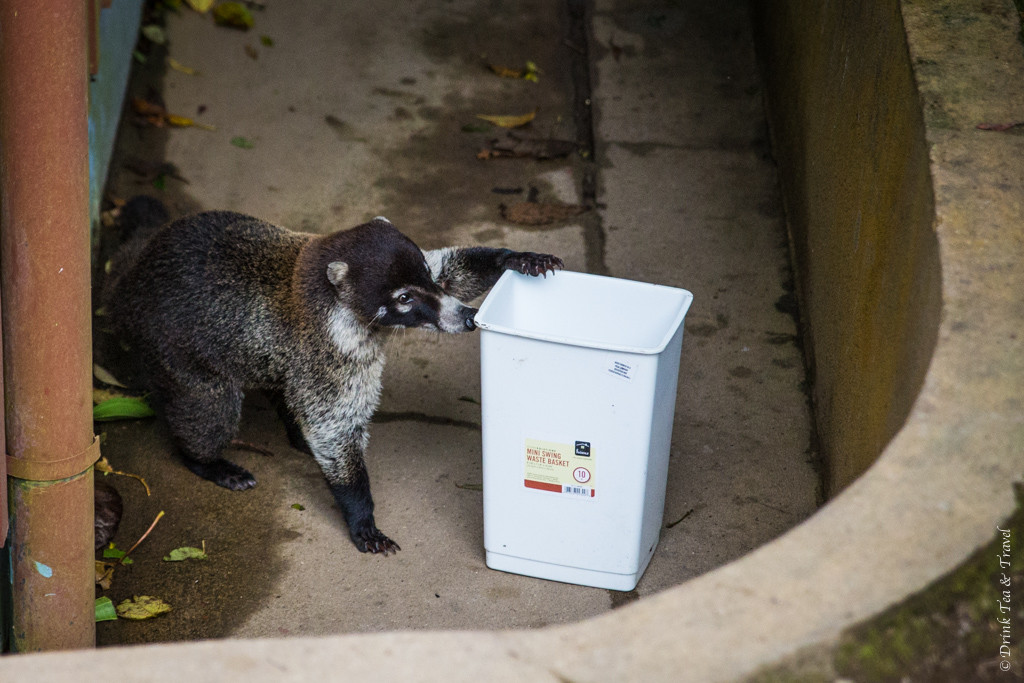
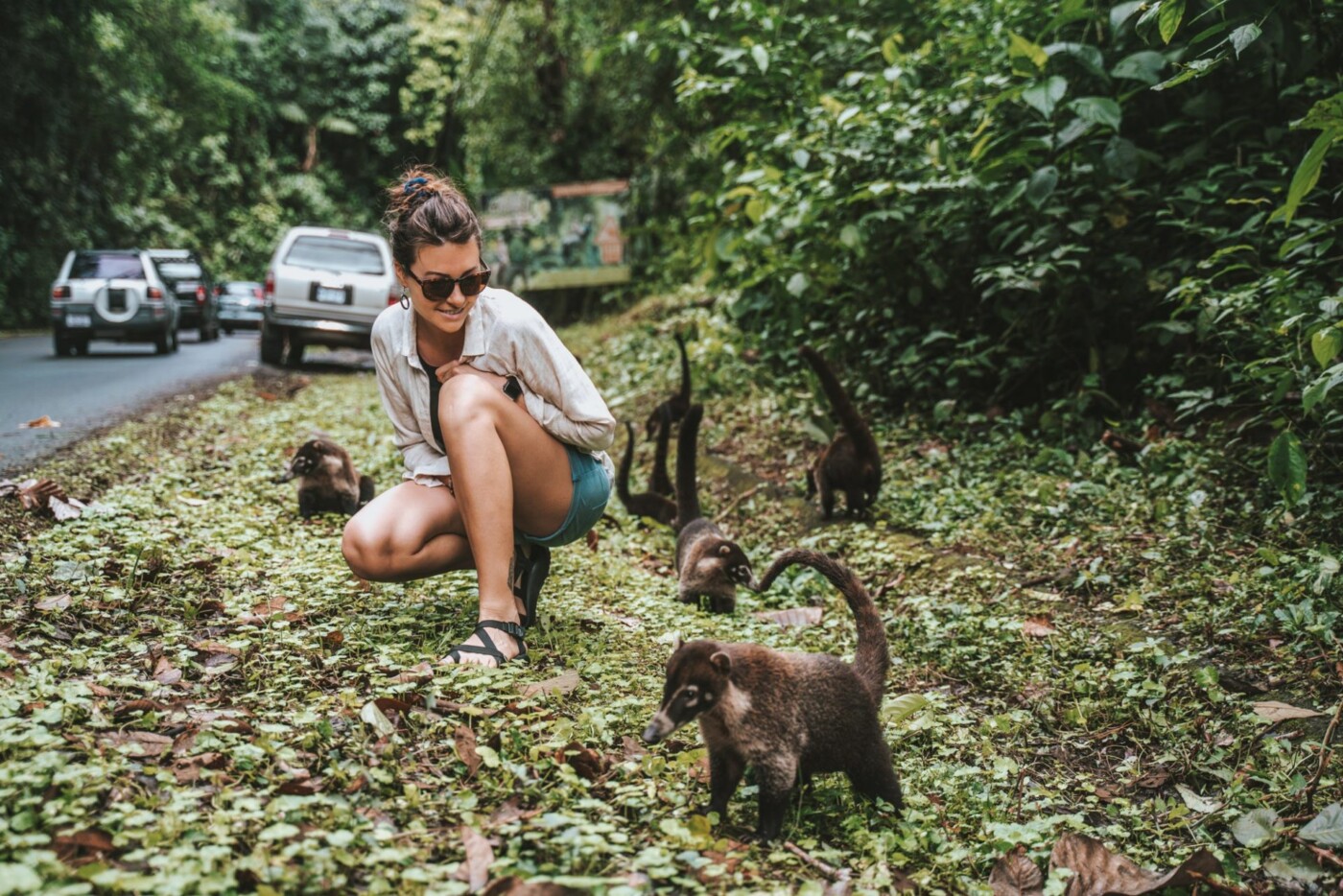
6. Keel-Billed Toucan
While different toucan species inhabit the majority of the South and Central American continent, this specific type is particularly popular on the Caribbean side of Costa Rica.
They are not easy to spot in the wild, but we loved that we got a chance to see one of these when we made a stop at the Las Pumas Rescue Center near Liberia.
This toucan was beautiful, proving that the animals in Costa Rica are just as bright and colourful in real life as they are in pictures!
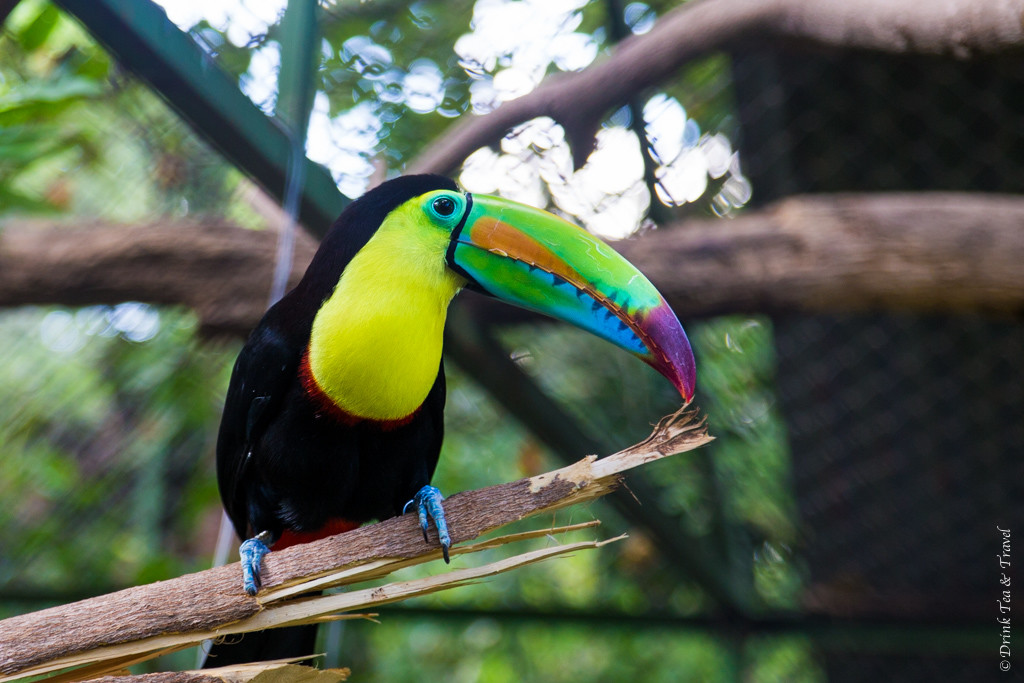
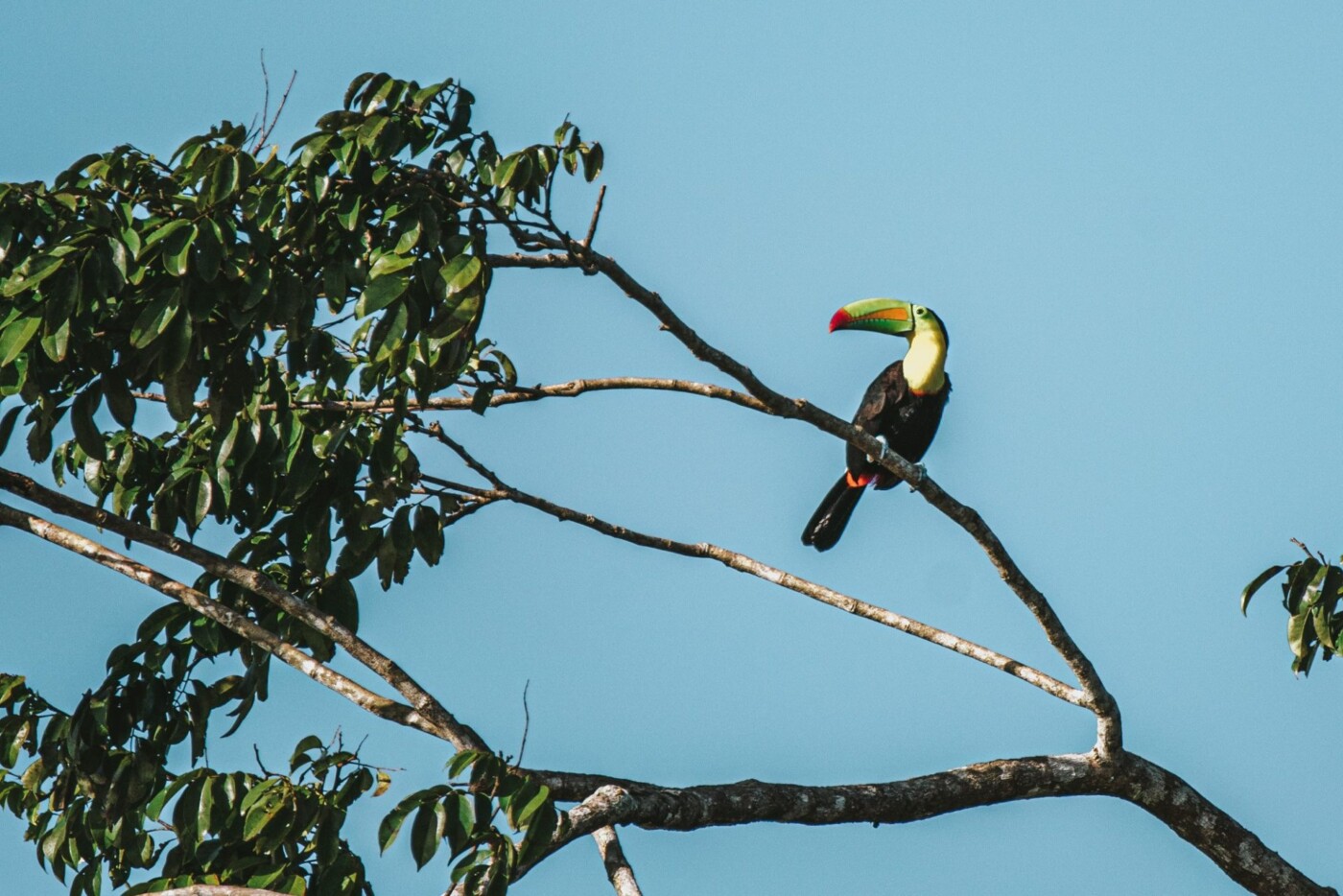
7. Ocelot
The Ocelot of Costa Rica, also known as a dwarf leopard, is an incredibly adorable-looking wild kitty that is prevalent in most areas of South and Central America.
Despite being extremely common and not at all endangered, these Costa Rica wild cats are elusive animals. Ocelots may spend their days resting in trees or other dense foliage, but seeing them in the wild, even in the animal sanctuaries of Costa Rica, is rare.
This little guy in the photo below was once kept as a pet in a Costa Rican home. When he grew up and proved he wasn’t a house cat his owners gave him up to the Las Pumas Rescue Center where he is based to this day.
Nothing beats seeing some of these awesome animals in the wild, but if luck isn’t on your side during your travels throughout Costa Rica, be sure to stop by the Las Pumas Rescue Center located on the Inter-American Highways on the way to Liberia for a chance to see the Toucan, the Ocelot and a few other unique Costa Rican animals.
The Rescue Center has done a great job at replicating the true habitat of these animals helping them live a better life no matter what their original life story was.
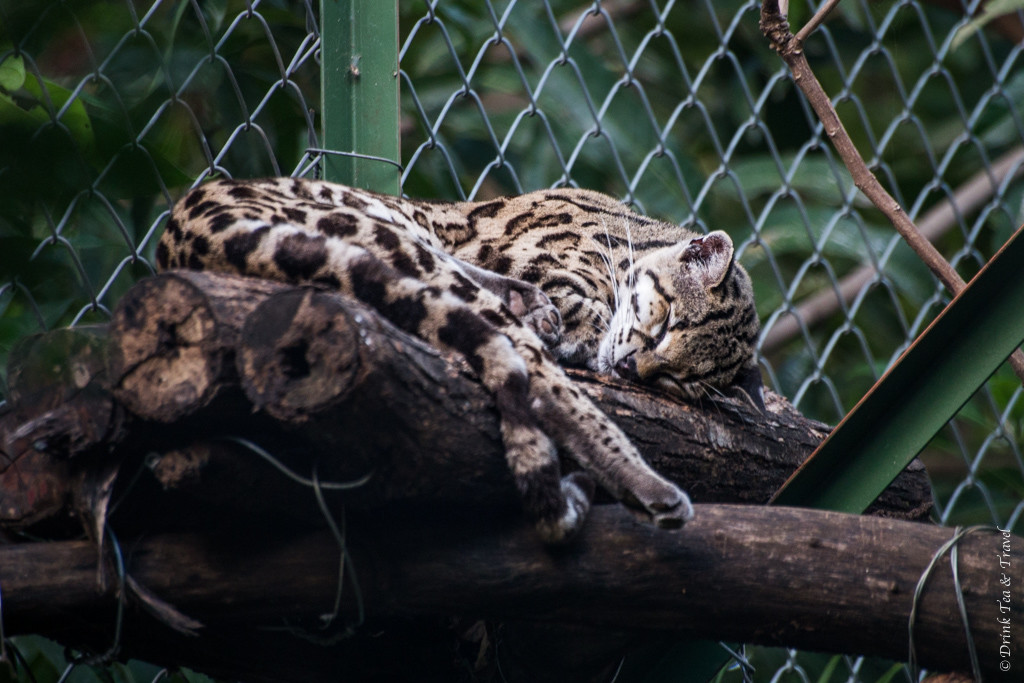
8. Poison Dart Frog
Can you believe that this little guy is one of the most dangerous animals in Costa Rica? They may be tiny and look pretty, but don’t be fooled. Their bright colours are a warning: Look, but don’t touch! The largest species of these little amphibians has enough toxin to kill up to 20 men.
Similarly to glass frogs, they are pretty tiny, so seeing them in the wild can be mission impossible. But, if you’re keen there are many animal sanctuaries in Costa Rica where you can try get a glimpse. The Arenal Natura Ecological Park has a fantastic frog garden where you can catch a glimpse of the small but deadly poison dart frogs.
Another good option for spotting this dangerous animal in Costa Rica is to plan a trip to Corcovado National Park. Located in the southwest of the country on the Osa Peninsula on the Pacific coast, and unique among the national parks, Corcovado National Park is home to over 40 species of frogs, including the poison dart frog.
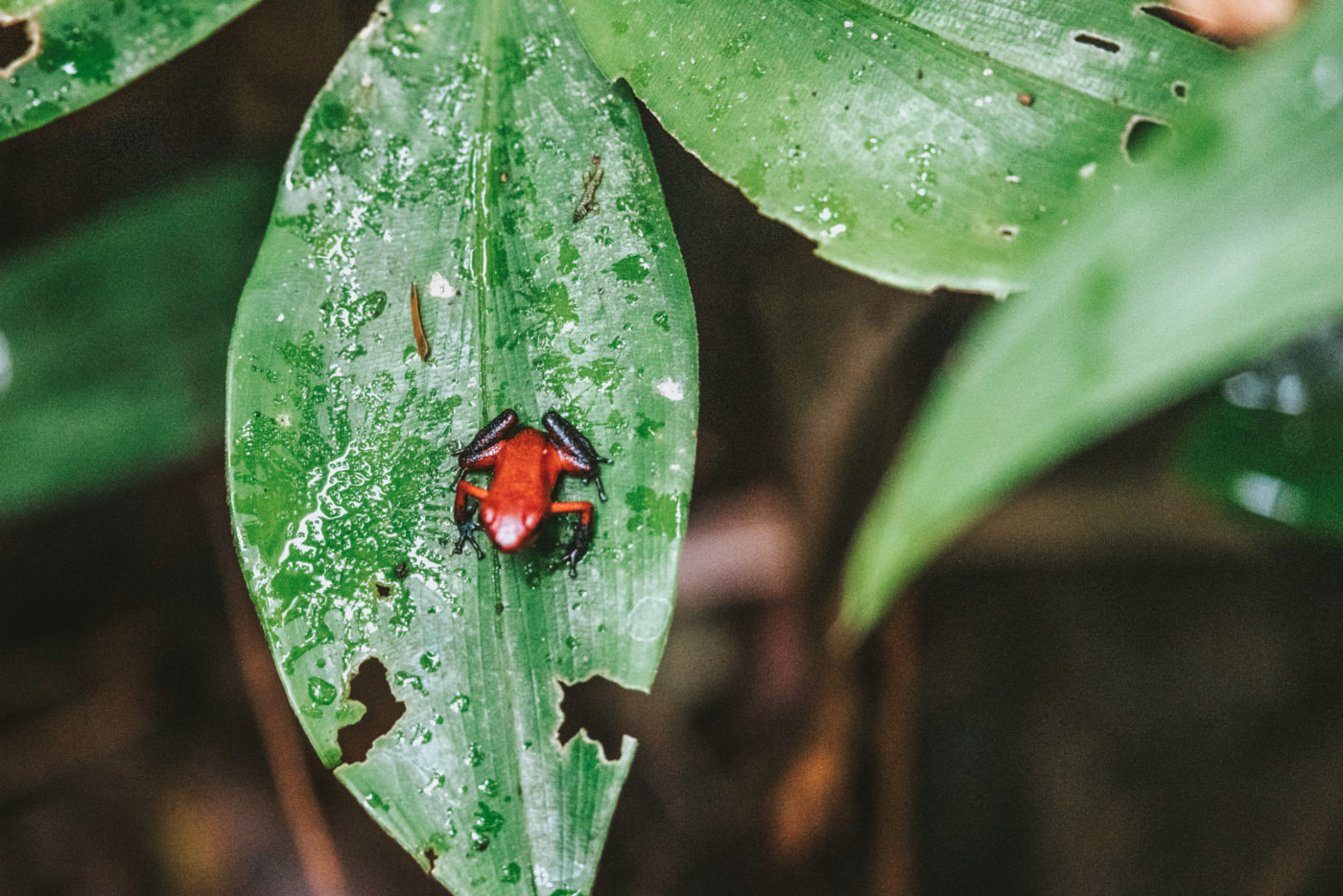
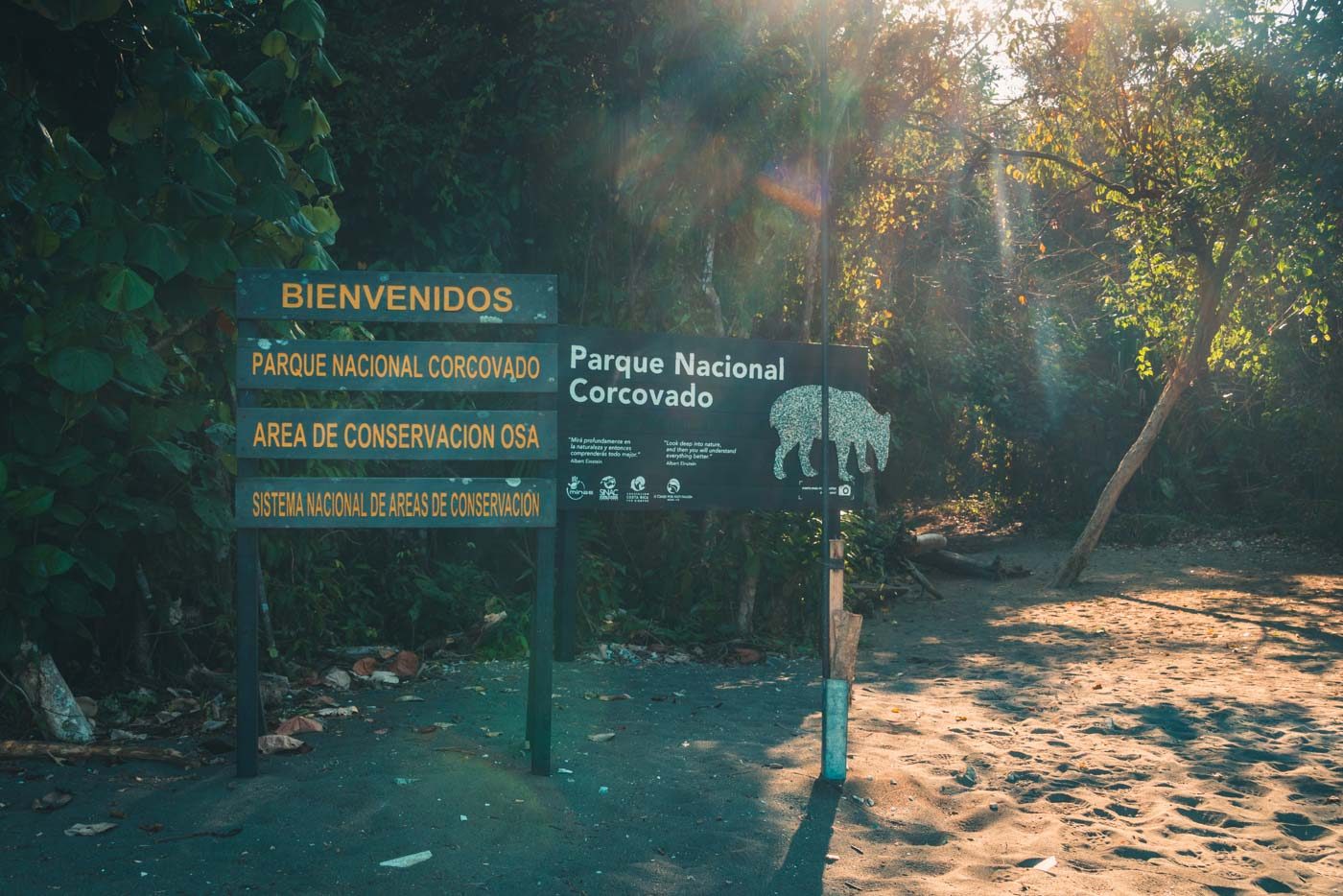
9. Crocodile
Perhaps not one of Costa Rica’s animals you want to come across on your travels! But if you are curious about this fascinating creature, then head to the Tarcoles Bridge, which is also known as Crocodile Bridge, and for good reason! There, you can see hundreds of these guys relaxing in the Tarcoles River just below the bridge.
The average crocodile in Costa Rica can be 13 to 16 feet long and weigh up to 1200lbs, making them one of the Americas largest species of crocodile. In Costa Rica, they tend to prefer the lowlands along the Costa Rican coasts but they are mostly restricted to the national parks, but just keep your eyes open when you’re in the water!
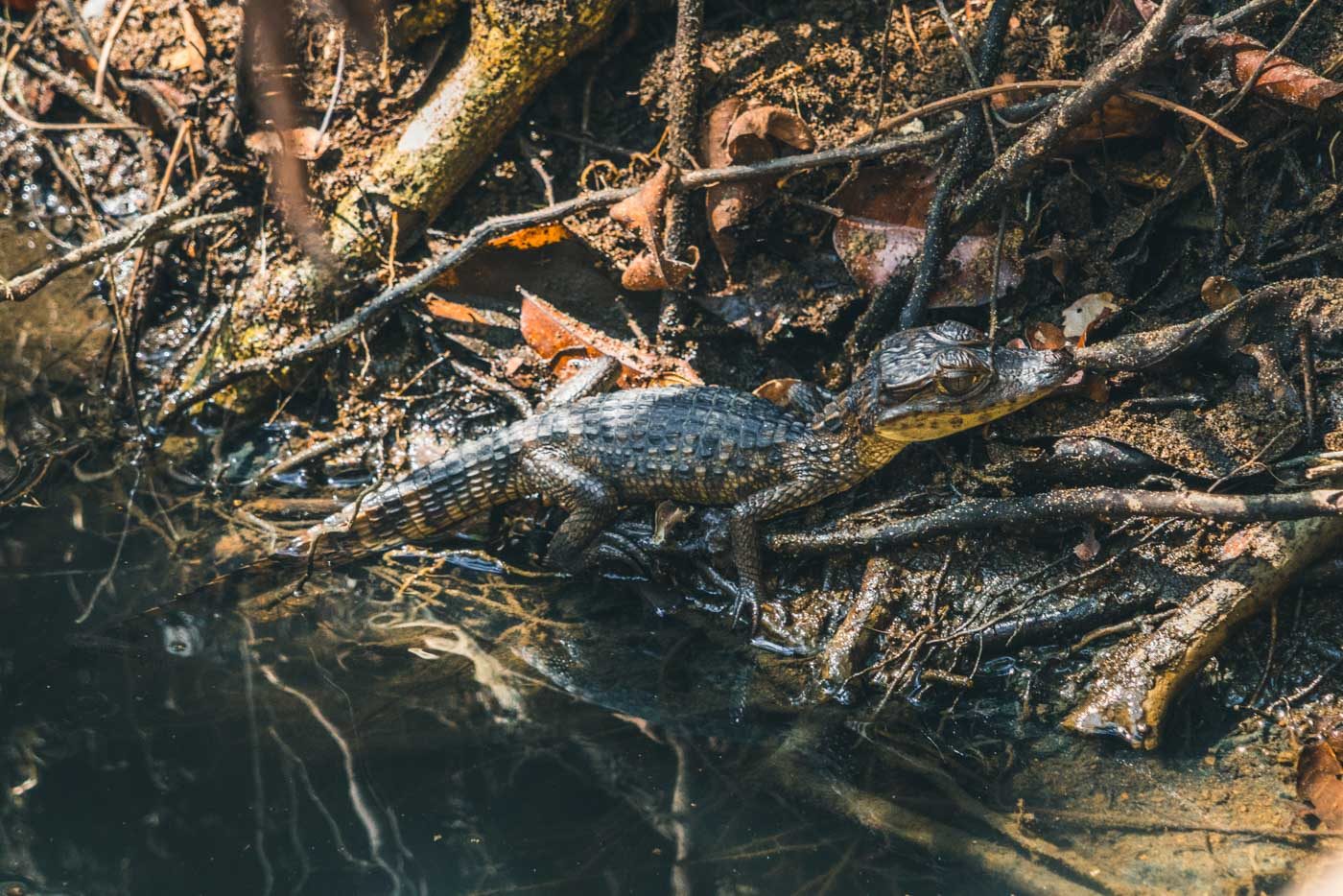
10. Tapir
The tapir is arguably one of the weirdest looking mammals we came across in Costa Rica. These herbivores feed off Costa Rica’s plant life, eating mostly fruit, grass, leaves and twigs. The gentle giants are usually around 6ft long and 800 lbs, making them the largest Costa Rican animal roaming the tropical forests.
However, tapirs are on the endangered species list so spotting one in the wild is unlikely, although not impossible. To be sure you catch a glimpse of these amazing creatures, we recommend visiting one of Costa Rica’s National Parks.
We were lucky to spot a tapir taking a stroll along the beach on our visit to the Corcovado National Park.
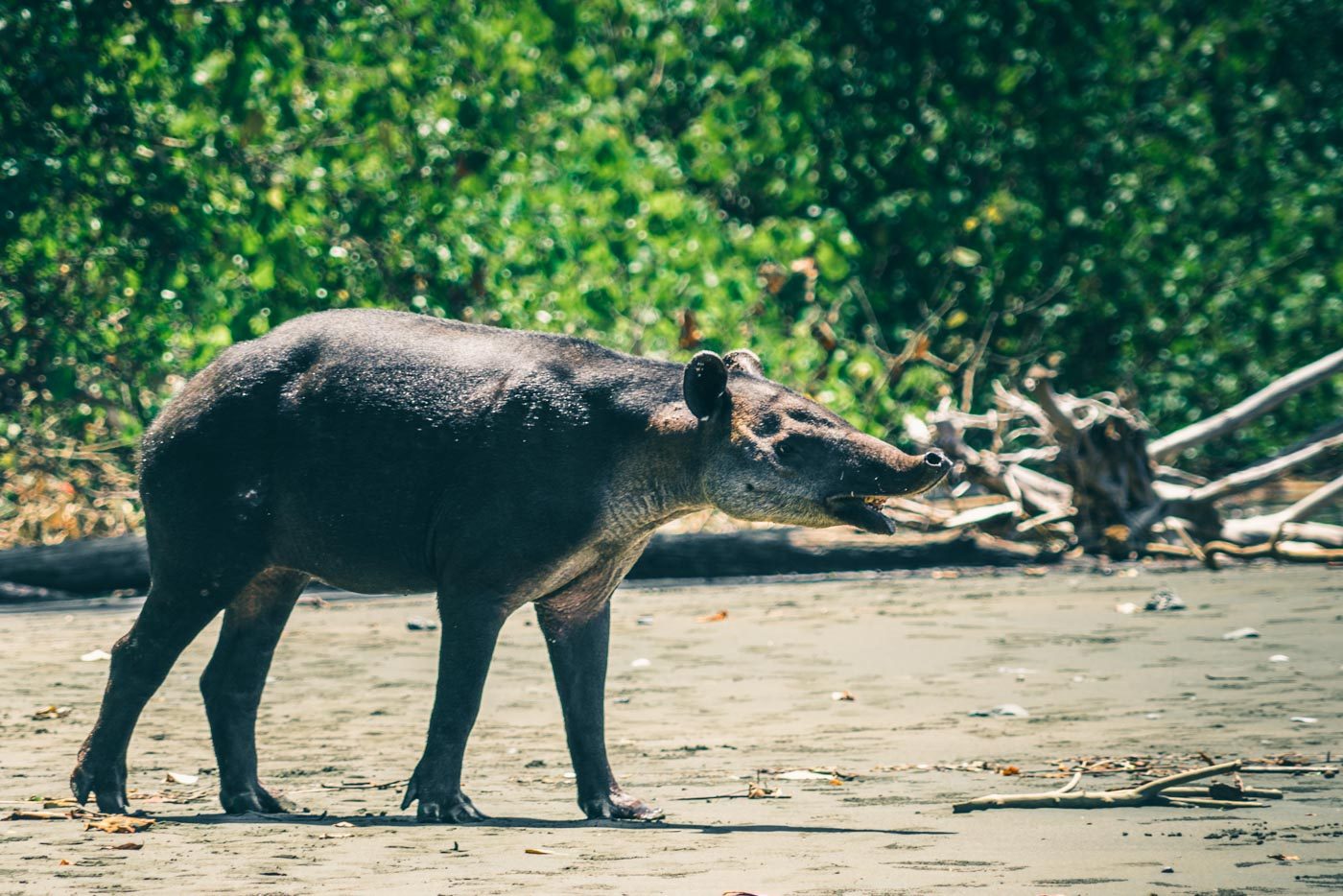
11. Sea Turtles
Among other wild animals, Costa Rica is well-known for its sea turtles. Their nesting seasons attract a lot of tourists, and depending on the time of year, visitors could see tens or hundreds of thousands of them on a beach to lay eggs.
There are five types of sea turtles in Costa Rica: Green Turtle, Oliver Ridley turtle, Leatherback Turtle, Loggerhead Turtle, and Hawksbill tutle. Green turtles and Leatherback sea turtles are the most well-known, though.
Shocking many visitors, the leatherback sea turtle is enormous. They’re over six feet long and weigh nearly half a ton. They can dive deeper and into colder water than other species of turtle, thanks to their softer shells and darker colors. They’re more common along the Caribbean coast but can also be seen during the nesting season in Playa Grande.
Green sea turtles can, on rare occasions, reach some truly impressive sizes, but they tend to average between 150 and 400 pounds. Depending on the time of year, you can spot them on Costa Rica’s Pacific coast or Caribbean coast.
The green sea turtles are endangered, so they may be scarce. For the best odds, try Tortuguero National Park between July and October.
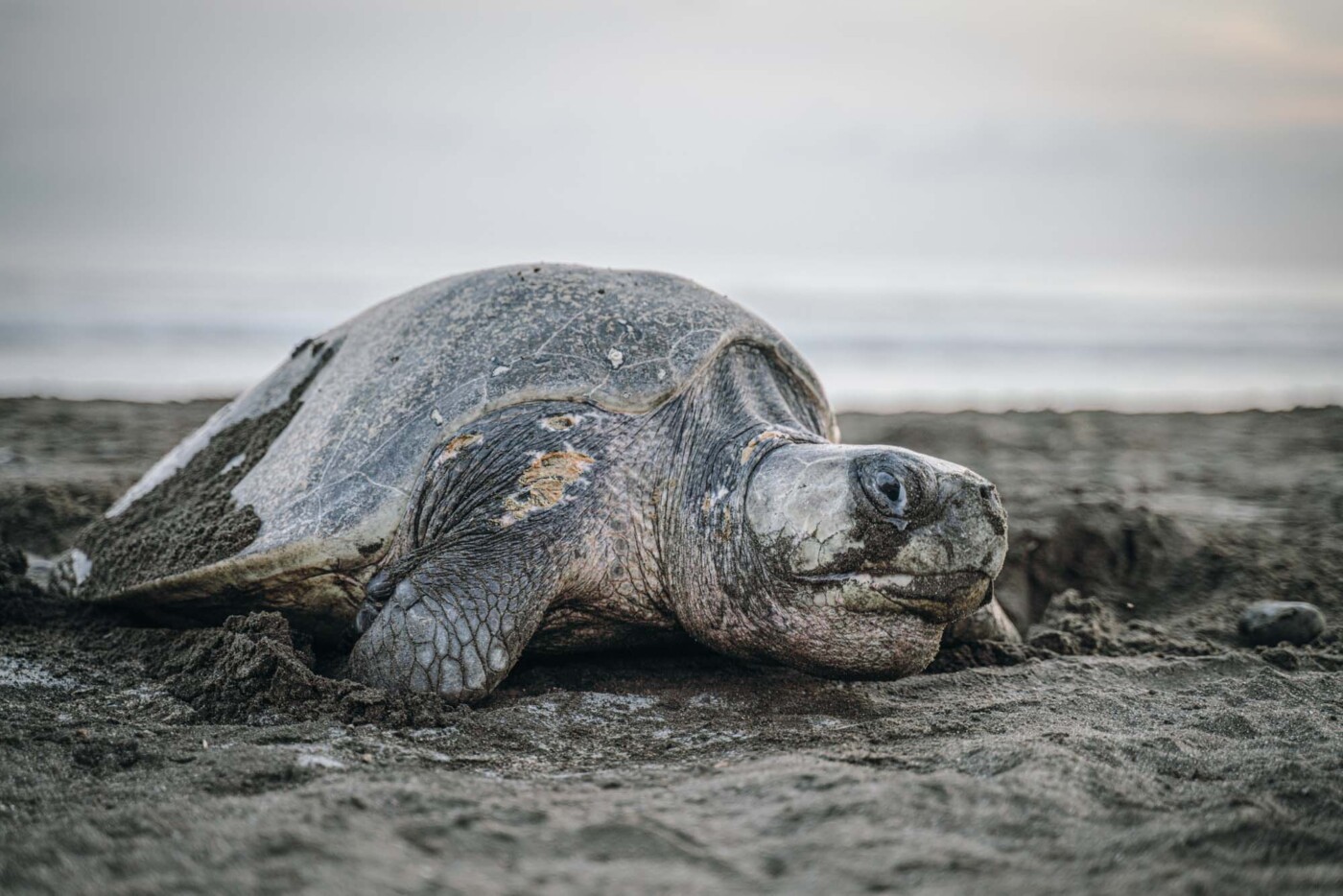
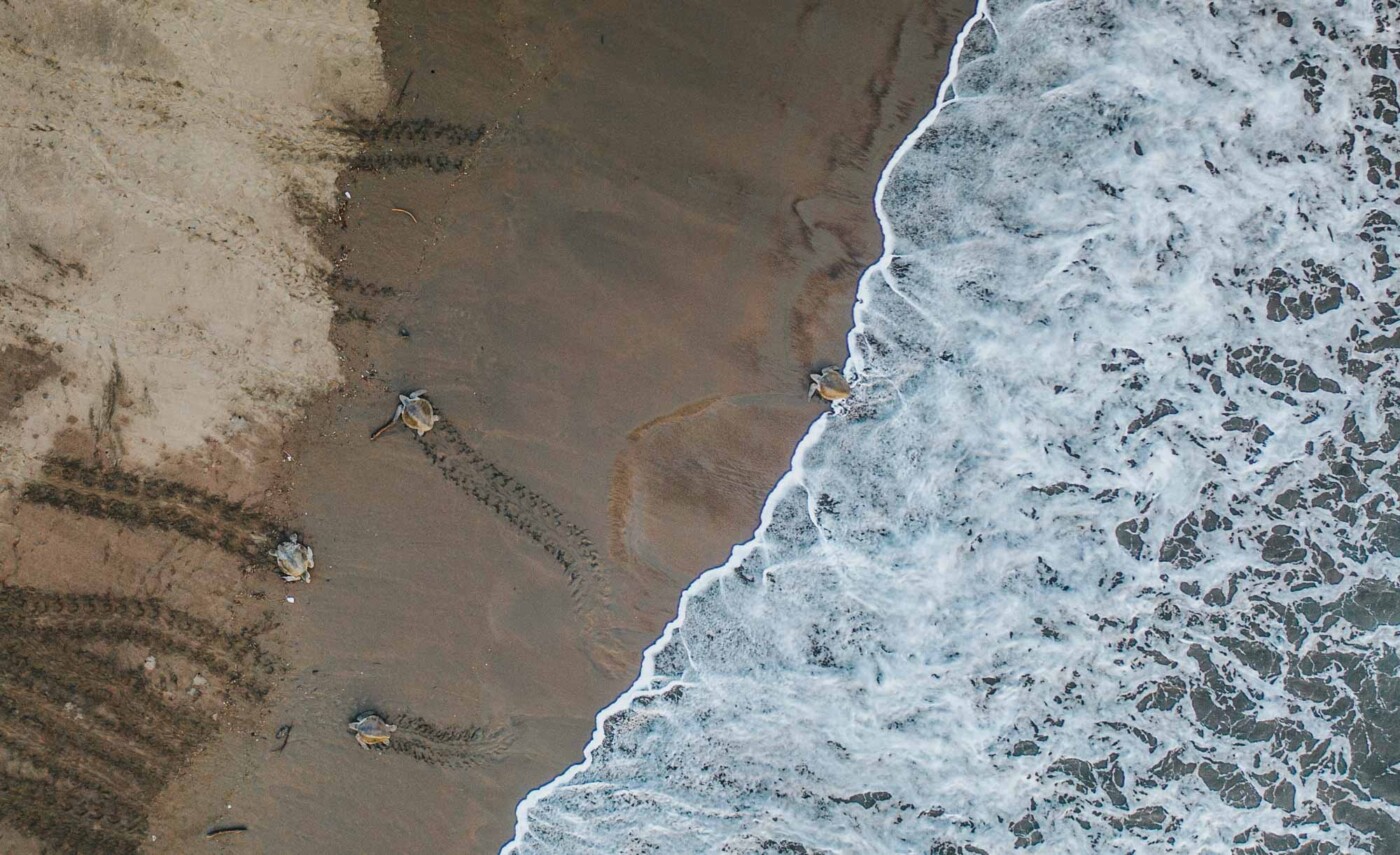
READ NEXT: Witnessing Arribada Turtle Nesting in Playa Ostional
12. Red Eyed Tree Frogs
There are many tree frog species in the world, but the red eyed tree frog is the most popular. The red eye tree frog can be found throughout Central and South America, and in Costa Rica you can see them on the Caribbean or Pacific coast.
The red-eyed tree frog isn’t endangered, but they are used as indicators of how the ecosystem is doing. This is because amphibians, including frogs, tend to feel the effects of environmental decline before many other species.
While many other animals so brightly colored are poisonous or venomous, that’s not the case with the red eyed tree frog. Instead, the bright coloring on these tiny carnivores is what’s known as startle coloration. They’re so brightly colored it disorients their predators.
Manuel Antonio National Park and Osa Peninsula are some fo the places were you might be able to spot a red eyed tree frog in Costa Rica.
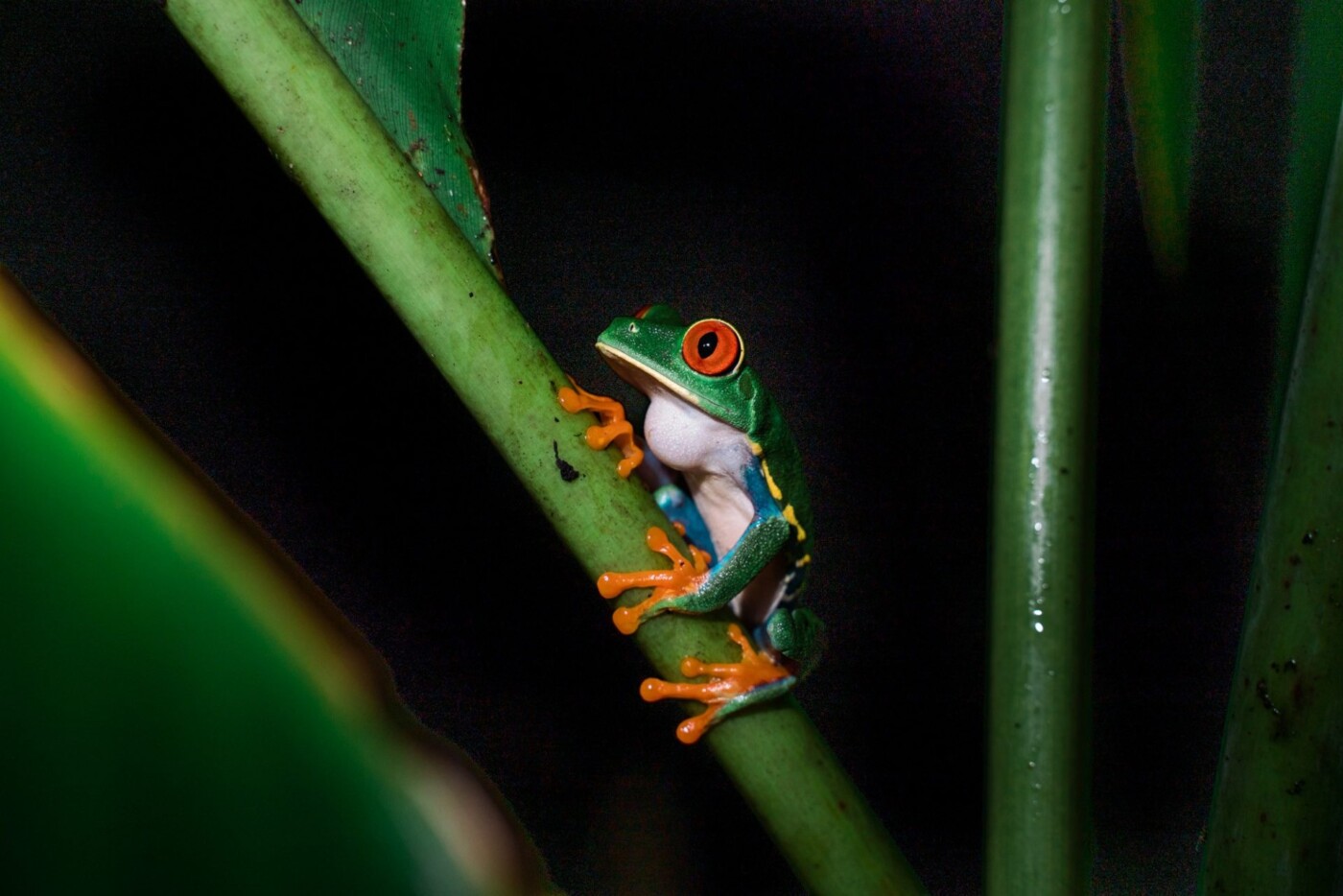
13. Humpback Whales
There are two varieties of humpback whale to see in Costa Rica. There are northern hemisphere whales and southern hemisphere whales, and while they are very similar, they’re not identical.
Northern hemisphere humpbacks typically show up in Costa Rica between December and April, as they migrate south from Canada and the North Pole.
Southern hemisphere whales are a bit bigger and tend to show up in Costa Rica between July and November, as they migrate up from Antarctica.
Topping out at 50 tons, humpback whales are enormous and majestic, and seeing them in person is an incredible opportunity you won’t often get. One of the best places for whale watching is Marino Ballena National Park in Uvita.
14. Green and Scarlet Macaws
Known for their bright colors and chatty natures, scarlet macaws and great green macaws are gorgeous and intelligent birds. If you want the chance to see them in the wild, though, you may not have much time left.
Though passionate conservation efforts are underway, both species are endangered. When it comes to the northern subspecies of the scarlet macaw, estimations are that there are about 3,000 left in the wild in Costa Rica. For the great green macaw, that number is only 400.
If you’re a fan of birdwatching, then these birds could be a dream come true for you, and not just because they’re beautiful. They’re social and frequently travel in pairs or groups and tend to be pretty calm when it isn’t mating season. Birdwatching is actively encouraged, as the interest promotes conservation.
Macaws can be spotted in many parts of the country, including Guanacaste, South Pacific and the Caribbean Coast. They are quite common in Manual Antonio and further down the South Pacific Coast, places like Uvita and Osa Peninsula.
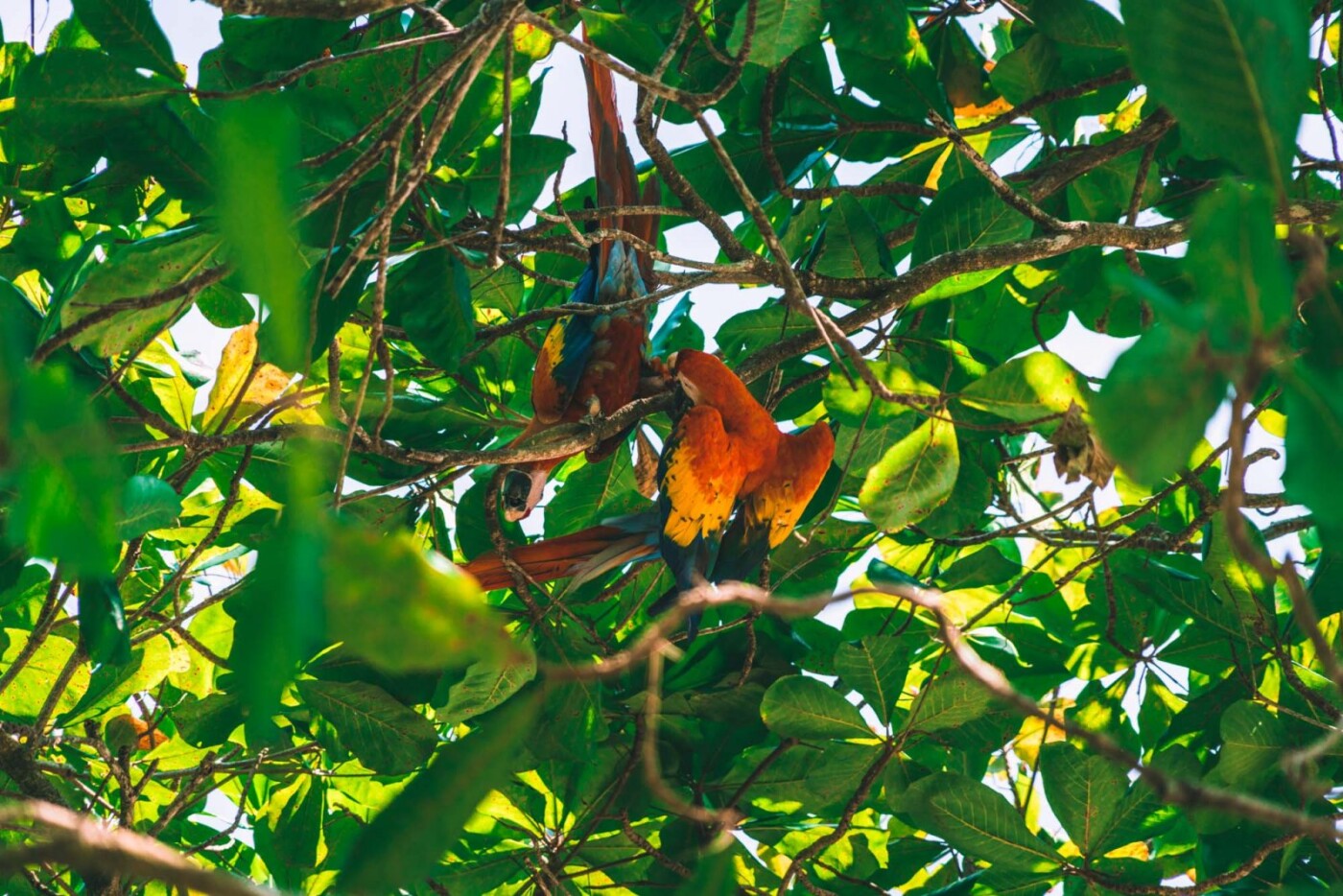
15. Blue Morpho Butterflies
The blue morpho butterfly is often considered to be the most recognizable butterfly species in Costa Rica. Despite that, there is quite a striking difference between the males and females of this species.
The males, as the name implies, are a vibrant, metallic blue. The females, by contrast, are brown. In either case, though, getting the chance to see one fluttering by is like magic.
If you’re hoping to find blue morpho butterflies while you’re in Costa Rica, then you’re in luck. It’s the perfect excuse for a day trip to one of Costa Rica’s National Parks. These butterflies are diurnal, so they’re out and about during the day.
16. Basilisk or Jesus Christ Lizard
When it comes to the wildlife in Costa Rica, few creatures are quite as unique as the basilisk, though it’s more commonly known as the Jesus Christ Lizard. It’s a strange nickname, but it makes sense once you see these little lizards in action. There are a few different subspecies in Costa Rica, but they all have a similar adaptation.
Thanks to their large feet and small size, a basilisk that’s been startled can gather enough momentum to actually run on water. The smaller the lizard, the longer they can go before finally sinking, with some able to run for up to 20 metres.
Of course, being small and fast also means they can be very hard to spot, so you’ll have to keep your eyes open. They’re diurnal, so your best chances of seeing them are if you’re hiking or on the water during the day. We’ve been lucky enough to spot them in Manuel Anotnio National Park as well as in Corcovado National Park and in Tortuguero.
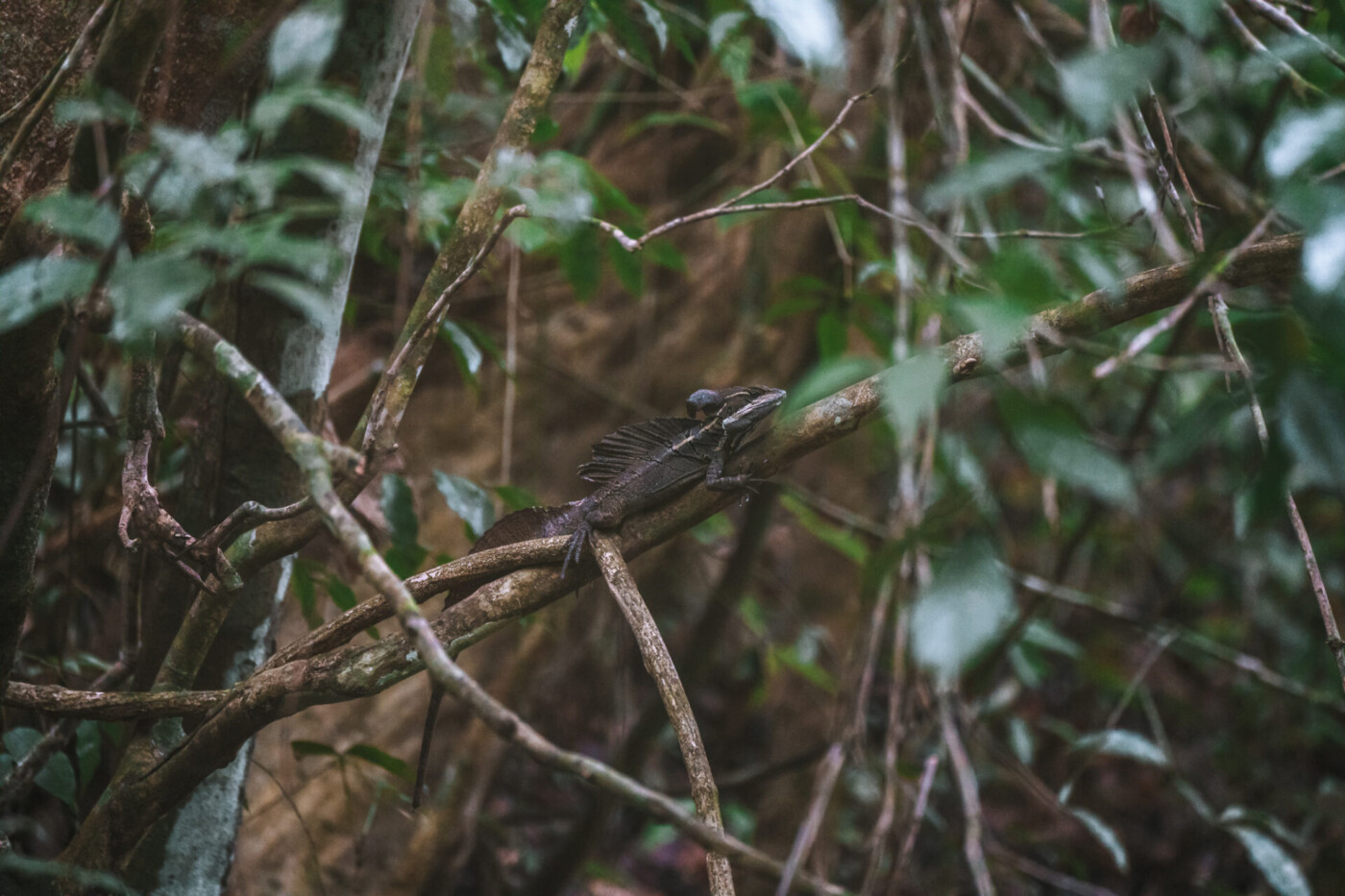
16. Green Iguanas
Green iguanas are one of the most recognizable reptiles in Costa Rica and can be spotted in many areas of the country, including forests, gardens, and even in urban settings. These large, colorful lizards can grow up to six feet long and are known for their distinctive, spiny crests along their backs. They are often seen basking in the sun on tree branches, rocks, or walls near water sources.
Where to See Animals in Costa Rica: Best Wildlife Tours
Manuel Antonio National Park
If you want to see lots of wildlife in Manuel Antonio, you have to get a guide! For $60 a person, you can get a guided tour through Manuel Antonio National Park. The guide is equipped with a telescope and knows exactly where to look for different species inside the park.
If you’re hoping to spot wildlife in Costa Rica, Manuel Antonio National Park has some of Costa Rica’s most iconic animals. You’ll see sloths, butterflies, frogs, snakes, bugs, toucans, squirrel monkeys, white-faced capuchin monkeys, howler monkeys, and possibly even spider monkeys.
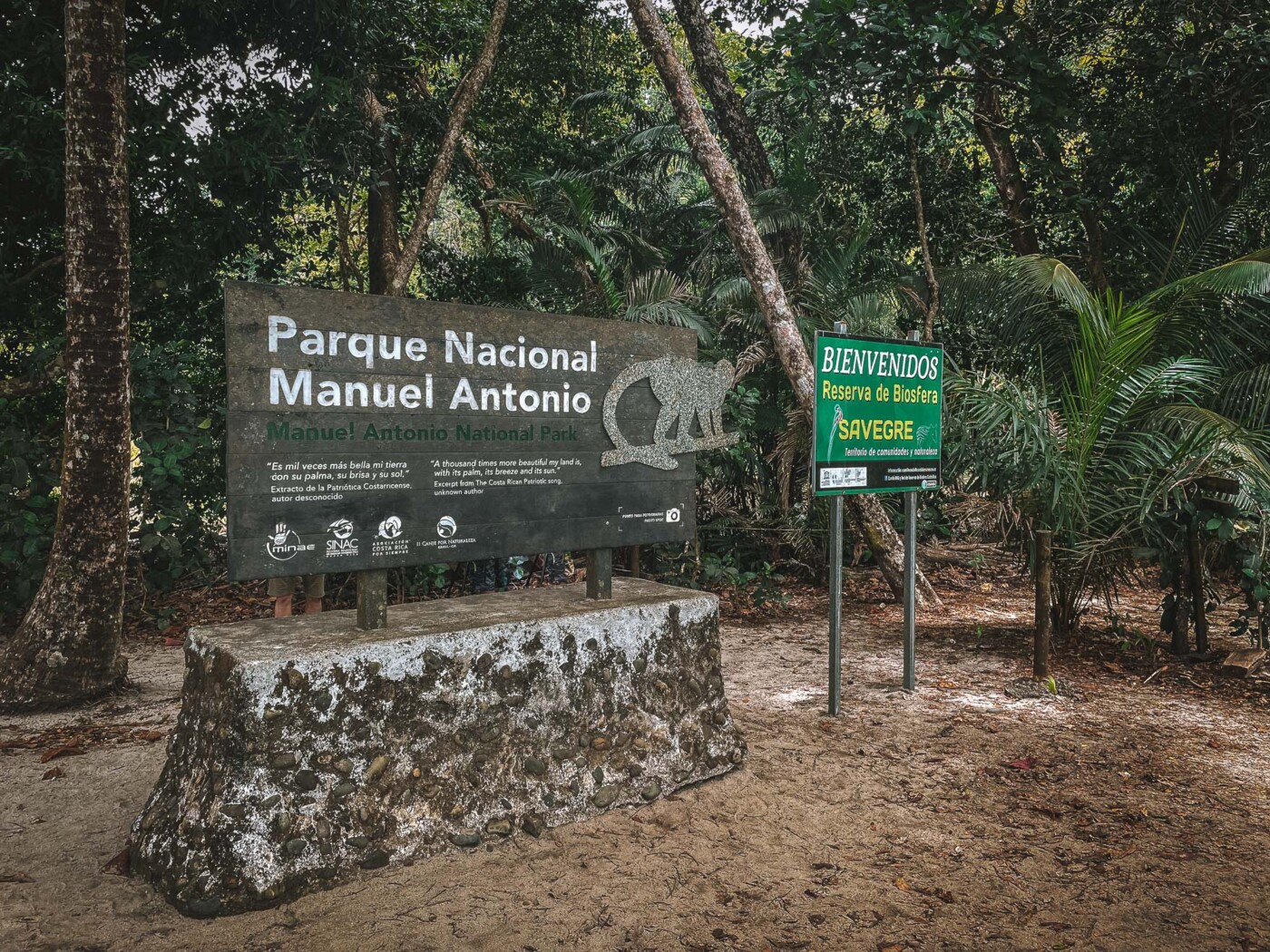
Monteverde Cloud Forest
If you want to spot some more nocturnal animals, consider a Cloud Forest Night Walking Tour in Monteverde.
The tour will give you a chance to observe the habits of nocturne mammals, birds, insects, reptiles and amphibians. The amount of Costa Rica wildlife you can spot in Monteverde is staggering. There are over 100 species of mammal, including all of the big cats in Costa Rica, tapirs, three monkey species, coatimundis, sloths, kinkajous, and 58 species of bat.
For birdwatchers, there are 400 species of tropical birds, including toucanets, quetzal, and hummingbirds.
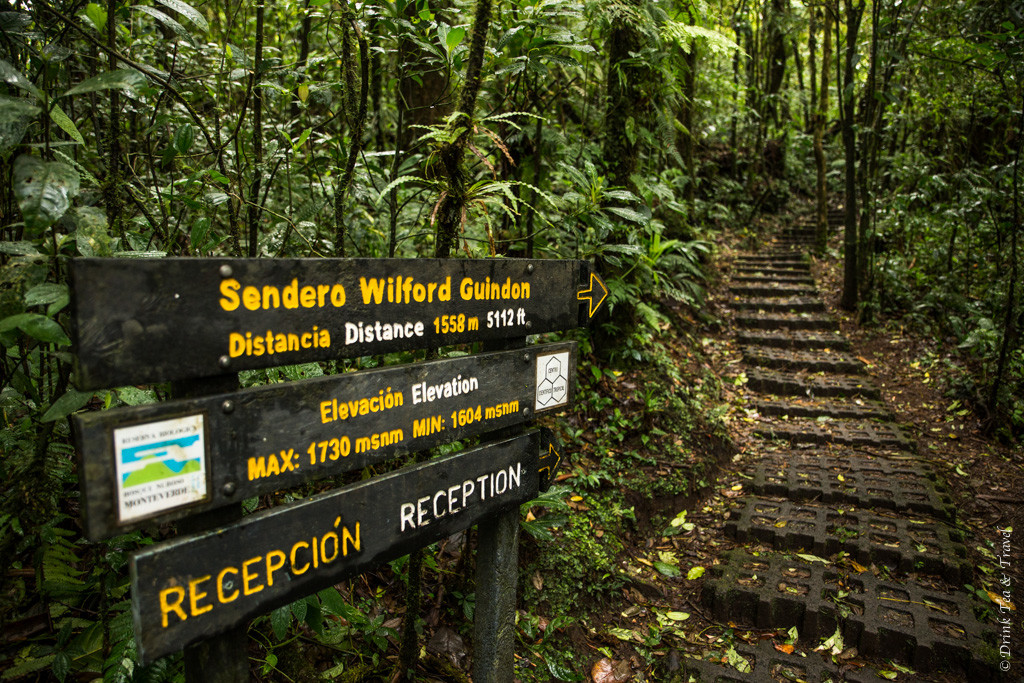
La Fortuna
If you’re looking for Costa Rica wildlife in La Fortuna, you can take a peaceful boat ride down the Penas Blancas River for $73, or you can take a guided tour of the Ecocentro Danaus Biological Reserve for $42.
In La Fortuna, you can see sloths, squirrel monkeys, spider monkeys, reptiles, butterflies, and birds, including toucans.
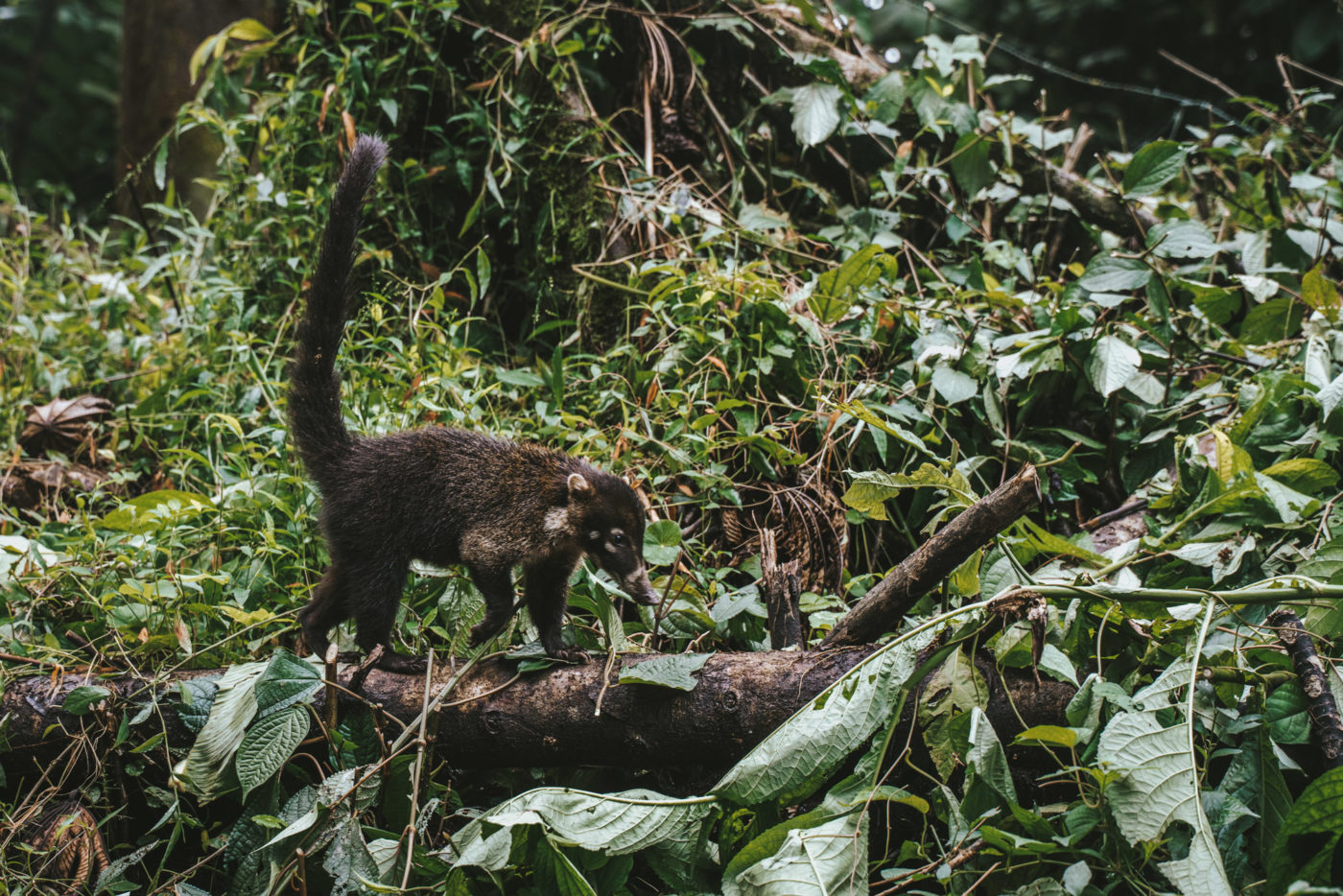
Carara National Park
If you are short on time and are staying in San Jose, consider a day trip to Carara National Park and the Tarcoles River. This full day tour costs $150 and gives you a chance to see a host of reptiles, spider monkeys, and dozens of bird species, including the endangered scarlet macaw.
Corcovado National Park
Corcovado National Park is a popular destination for seeing wildlife in Costa Rica. It is home to a diverse range of animals, including monkeys, sloths, jaguars, tapirs, and a variety of bird species.
You can explore the park on foot or by boat but only on a guided tour. You can visit the park on a day trip from Drake Bay or an overnight tour
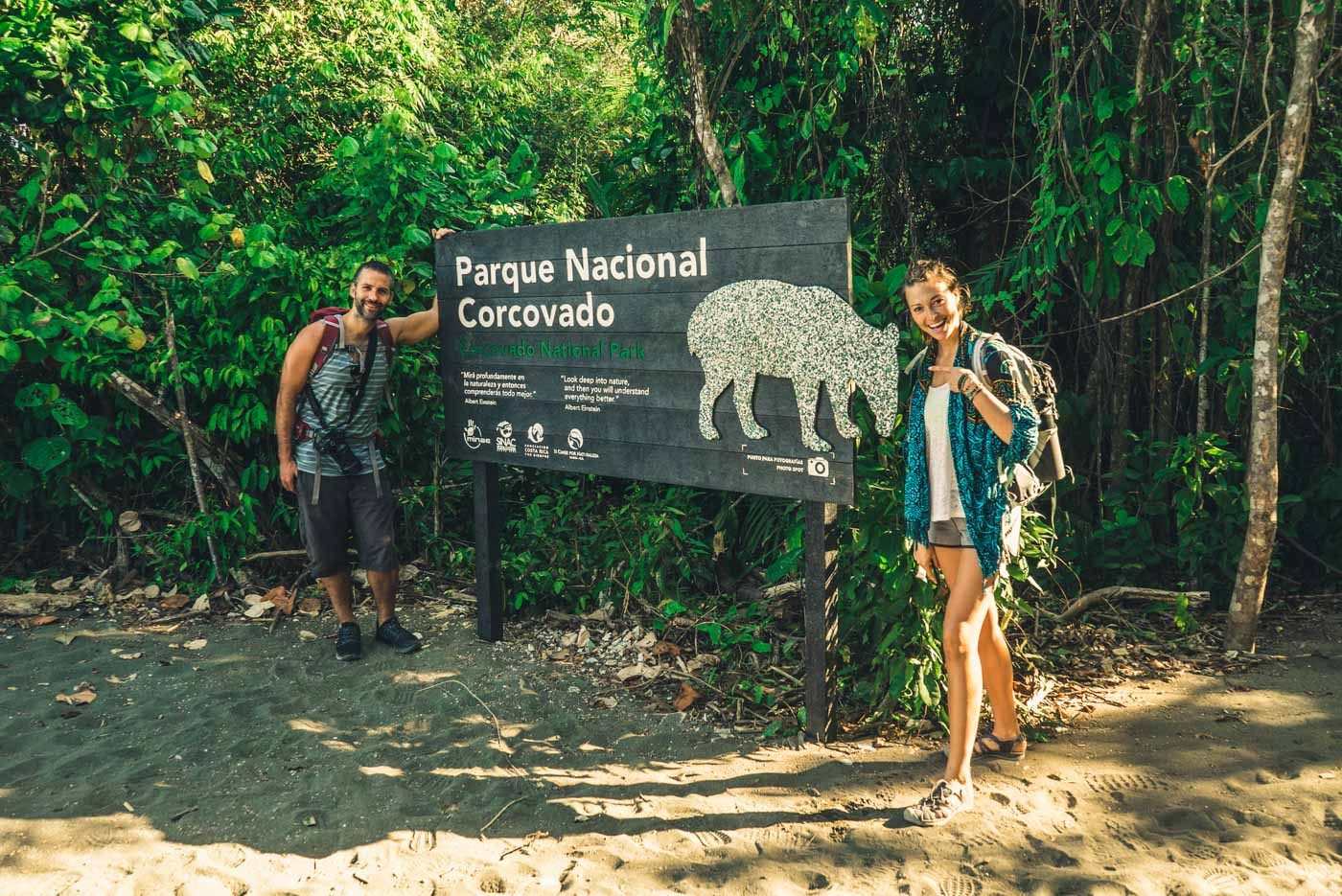
READ NEXT: Visiting Corcovado National Park

